Winterizing your garden can be overwhelming, so I’ve put together a detailed checklist for you.
In this list I’ve included everything that I do. It helps me stay on task and organized so that I get as much done as I can before the snow flies.
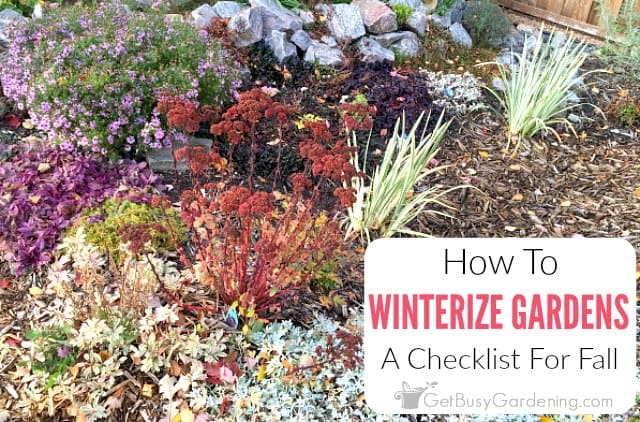
When To Winterize Your Gardens
The best time to start winterizing gardens is after the first hard freeze in the fall. This will kill off all of your tender annual plants and vegetables.
Freezing temperatures will also trigger perennial plants to start going dormant, so you know it’s safe to start cutting them back.
Of course, you don’t have to start right after the first freeze. You can take your time and work on these tasks all the way up until the snow flies.
Related Post: 5 Essential Fall Garden Tasks You Should Never Skip
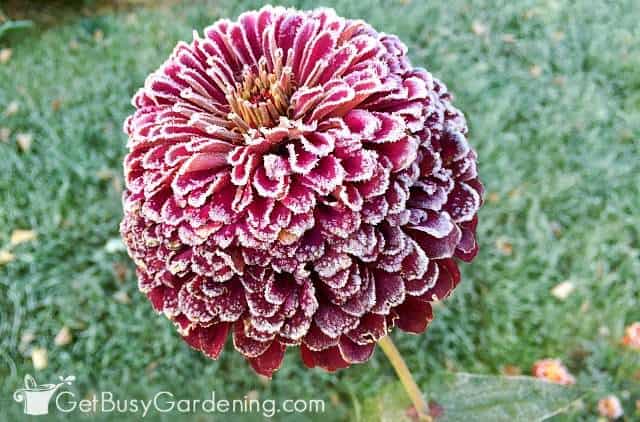
How To Winterize Your Garden (Checklist)
Below is my detailed checklist that includes everything you need to do to get your garden ready for winter. I included steps to take for your perennial, annual, and vegetable beds, as well as tips for your yard and lawn too.
Weeding
Fall is the perfect time to weed your gardens. Once the plants die back, it’s easier to see the weeds that have been hiding all summer.
Water the soil a few hours beforehand to soften up the soil and make pulling the weeds much easier.
Mulching
If you have any tender perennials that will need extra protection during the winter, you can use mulch as a cover. Leaves, pine needles, and other organic materials are the best.
You can cover the whole bed with leaves if you have enough, or just bury the most tender plants.
Watering
It may seem silly to worry about watering plants while winterizing your gardens. But keeping them well hydrated will ensure they survive the cold weather, especially if you had a summer drought.
Amending The Soil
Fall is the best time to amend your garden beds. Compost is great for any soil type, and a natural way to add more nutrients.
But before you add any amendments, be sure to test your soil first so you know exactly what it needs. It’s easy to do with a home test kit.
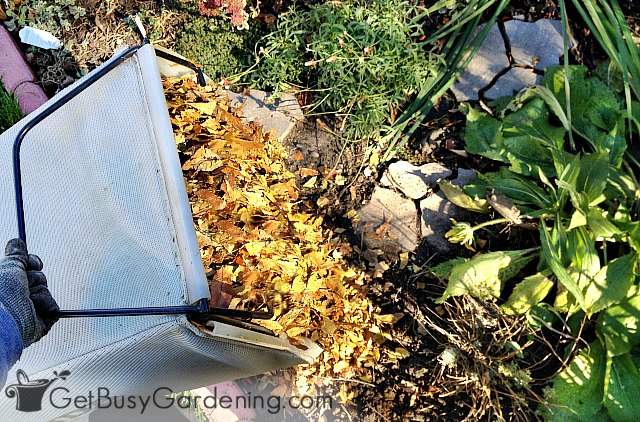
Deadhead Self-seeders
Next, I focus on cutting back perennials that are aggressive self-sowers (black-eyed Susan and other rudbeckias, liatris, butterfly weed…etc). These plants can sometimes become weeds if you leave the seed pods in the garden over winter.
Cutting them back before winter saves me hours of weeding every summer. Of course if you want those volunteers in your garden, then you can take this item off your checklist.
Winterize Your Perennial Garden
The last thing I do to winterize my garden is to work on cutting down the rest of the perennials, as I have time.
However, I don’t cut everything down because I like to leave some plants for winter interest and food for the birds.
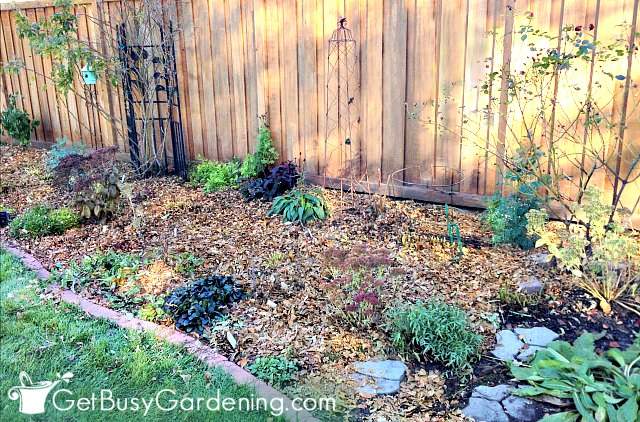
Dig Up Tender Bulbs
I grow tropical bulbs (dahlias, cannas, elephant ears, gladiolas… etc) in my flower beds, so the first thing I do after freezing temperatures have killed off the plants is cut them down. Then I dig up the bulbs and store them for winter.
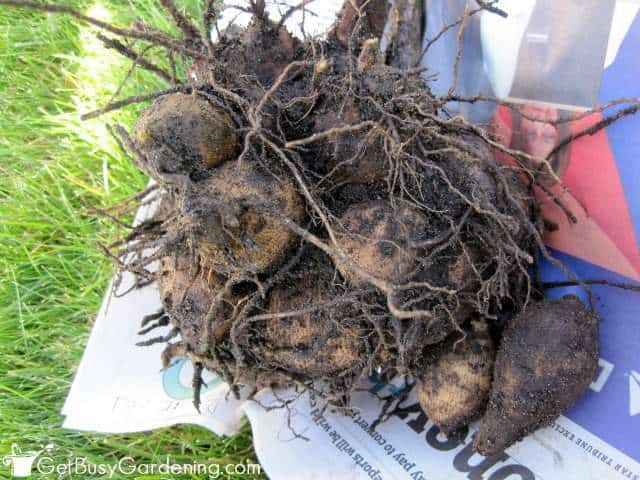
Winterize Your Annual Garden
Once a hard freeze has killed everything in my annual beds, I pull all of the plants out by the roots and toss them into the compost bin.
Some years I’m too busy to pull them all, so I’ll clean up the rest of my garden in the spring. Don’t worry, there’s no harm in leaving them out there through the winter.
Remove Dead Vegetable Plants
To prevent diseases and pests from overwintering on plant material, it’s important to clear our your vegetable garden.
After the first hard freeze has killed off your garden, be sure to remove all of the dead vegetable plants as your top priority.
Related Post: How To Prepare Your Vegetable Garden For Winter
Destroy Diseased Plant Material
Don’t put any diseased or infested plants into your compost bin. Throw them into the garbage or burn them to destroy the pathogens.
This is a super important step to take while winterizing your garden, and will help to prevent recurring disease and bug outbreaks.
Winterize Tender Garden Plants
You can bring many types of tropical plants, succulents, and tender perennials indoors for the winter. Just be sure to clean and debug them first.
To make it easy, you can keep cold hardy plants in an unheated garage or shed to give them extra protection through the winter.
Related Post: How To Overwinter Plants: The Complete Guide
Rake Leaves Off The Lawn
Allowing leaves to sit on the lawn all winter could create dead patches. So it’s important to rake them up before it snows.
Leaves are great to use as natural mulch for your vegetable garden, around your perennials, or in your compost bin.
You can also mulch them into the grass using your lawn mower if you don’t want to rake, which adds wonderful nutrients to the soil.
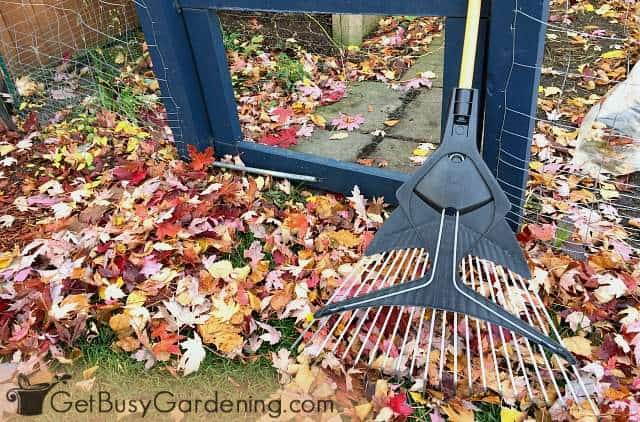
Cut The Grass Short
In the fall as the lawn starts to go dormant, lower your mower blade to give your grass a nice short cut.
Consider bagging the clippings to throw into your compost bin or till them into your vegetable garden (as long as the grass hasn’t gone to seed and you don’t chemically treat it). Fall is also a great time for aerating and dethatching. Get more lawn mowing tips here.
Winterize Your Garden Furniture
Storing it in a garage, shed, attic, or basement will help it last longer. However, if you don’t have the space, then consider buying protective covers for them.
If any of your outdoor furniture has decorative tile on it, then I highly recommend finding a place for it inside rather than just covering it. Tiles can pop or break in extremely cold climates ruining the piece (not that I would know that from experience).
Empty & Protect Water Features
It’s important to empty small water features, like bird baths and fountains, and protect them over the winter.
You can get a fountain cover or a birdbath cover to protect them outside, or you can move them indoors if you have the room.
Drain Irrigation Systems
If you have any type of garden or yard irrigation system, like underground sprinklers or drip irrigation, then make sure to turn them off and blow them out using an air compressor before freezing temps arrive.
You should also drain your garden hoses and store them in your garage, shed, or other protected location for the winter.
Winterize Garden Ponds & Waterfalls
In warmer climates, you may be able to leave your pond pump running all winter to keep the water from freezing over.
But in extreme climates like mine here in MN, you need to turn off the pump and waterfall to prevent damage.
You should also use a pond heater if you have plants or fish, to prevent the water from completely freezing over. Learn exactly how to winterize your pond here.
Empty & Store Your Rain Barrel
If you leave water in your rain barrel through the winter in a cold climate like mine, it would most certainly be damaged or destroyed.
So make sure to winterize your rain barrel, and store it somewhere safe. I turn mine upside down and put it behind our porch where it’s protected from the sun.
More Seasonal Gardening Tips
- 5 Tips to Simplify Fall Garden Cleanup
- How To Protect Plants From Frost Damage
- How To Plant Spring Bulbs In The Fall
Share your tips for getting your garden ready for winter in the comments section below!

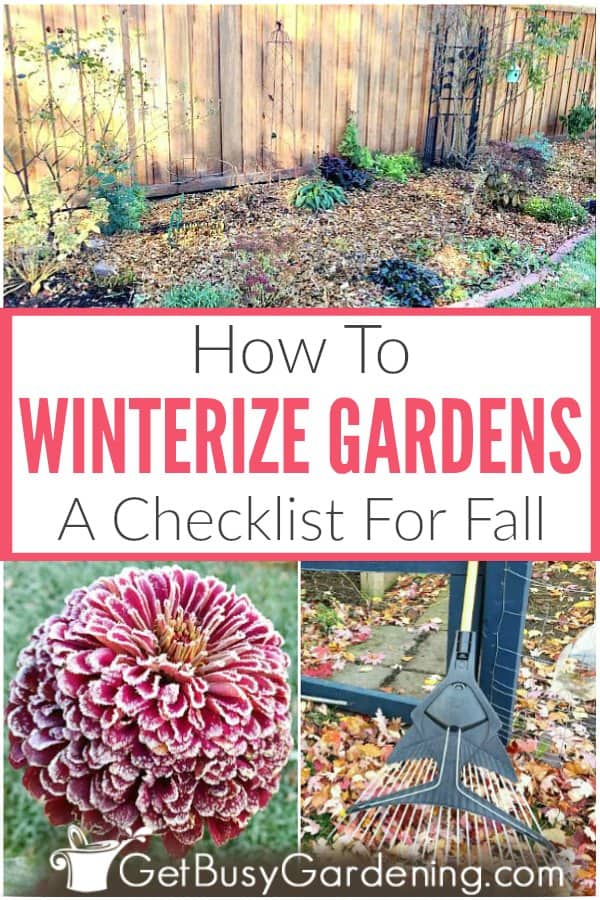
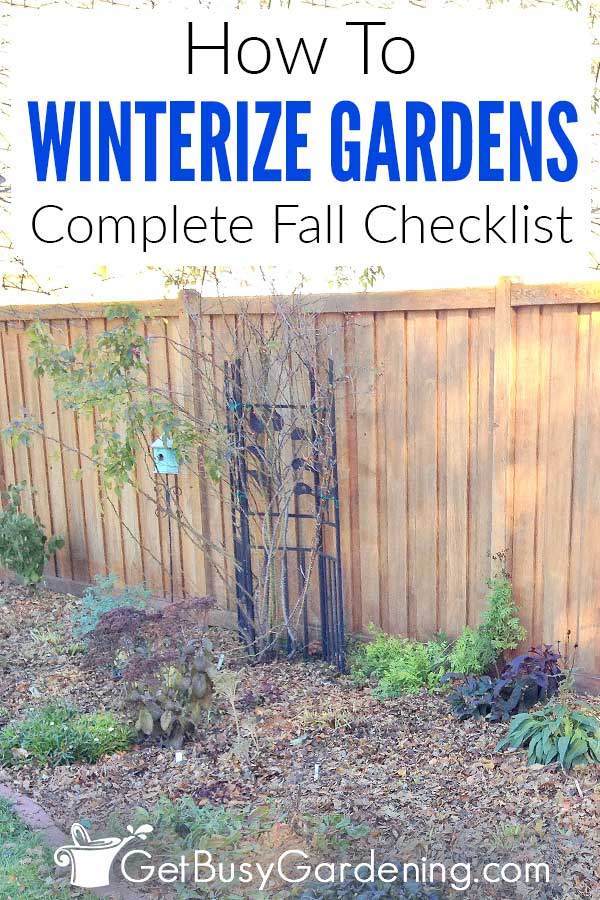
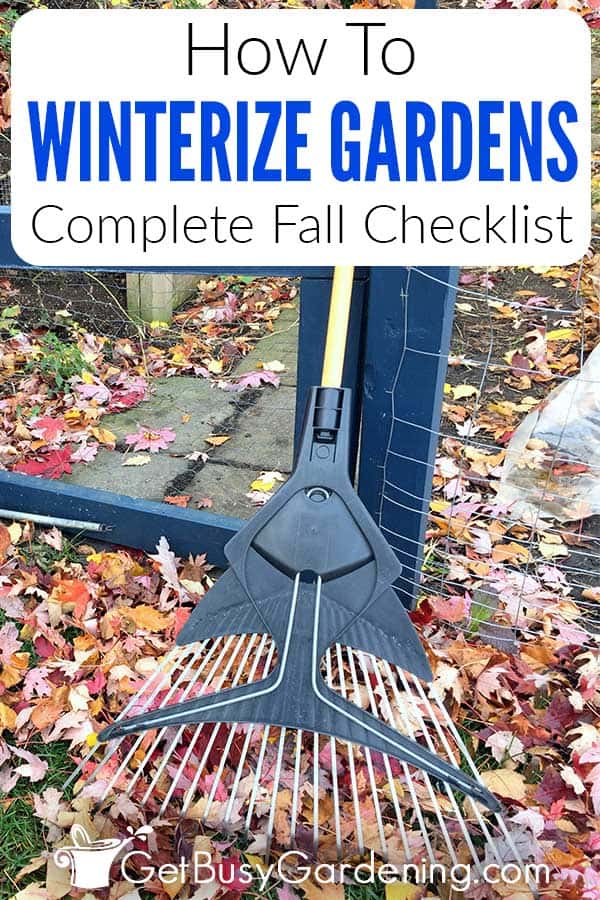
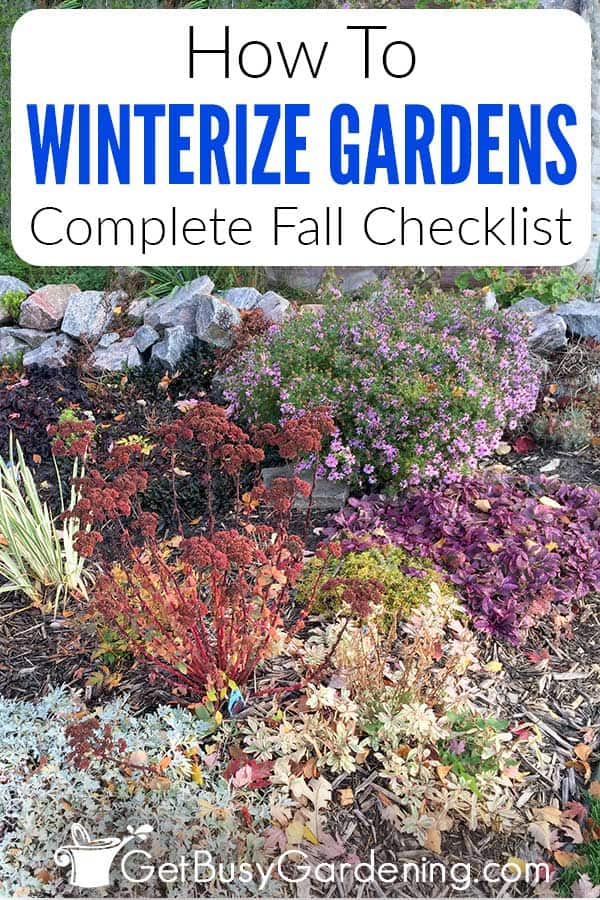
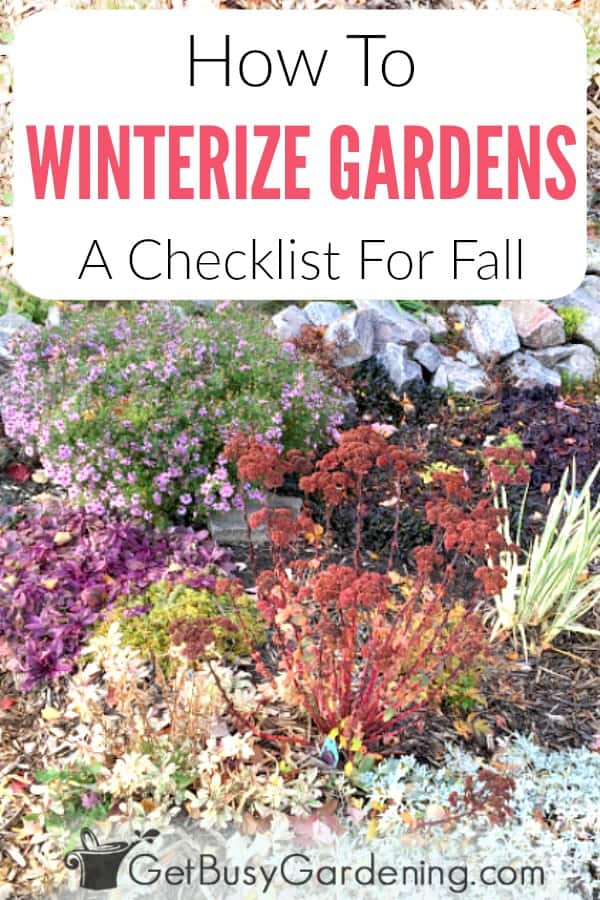


Nadine R. says
I’m a first timer on a perennial garden this year. We have a beautiful garden with 2 huge maple trees above it. I’m wondering if there’s a way to prevent the leaves from going into the garden because if we leave it the way it is then there will be alot of leaves on the mulch.
Amy Andrychowicz says
I don’t think there’s any way to prevent the leaves from fall into your garden, unless you want to try covering the whole thing with shade cloth or some other type of cover. But don’t worry, the leaves are good for your garden! They work as a winter mulch to protect the plants, and as they break down they feed the soil. I leave the leaves in my garden all winter (I even rake them into it). If there are still a lot of them in the spring, I will remove them during my spring clean up. You can always freshen the mulch in the spring, and just put it right over top of the leaves.
Maggie Morish says
Hi Amy,
As always, nice post!
I actually didn’t find your guide long and overwhelming. In fact, you’ve covered, pretty much, everything about winterizing a garden. After all, your garden can never be too prepared for the colder months ahead.
Amy Andrychowicz says
Awesome, I’m so glad you didn’t get overwhelmed by my long list! 🙂
Valerie A. Spring says
Thanks so much Amy! Your list was pretty comprehensive, and I learned quite a few great tips!
I loved the “lasagna method”. It saved me hours of back breaking work.
You are right…it IS easier to have a list made out for winterizing my gardens. Kudos to you for doing that for me!
Amy Andrychowicz says
You’re welcome, I’m so glad you found it helpful! I love the lasagna method too, it makes things SO MUCH easier!!
Amy Andrychowicz says
Meredehuit – I hear you! It's been a busy fall, and I still have lots to get done in my gardens before winter hits too!!
Meredehuit ♥ says
Great post! You just about covered it all…I'm not quite done with winterizing all of my gardens, but have to finish soon as snow is in the forecast.